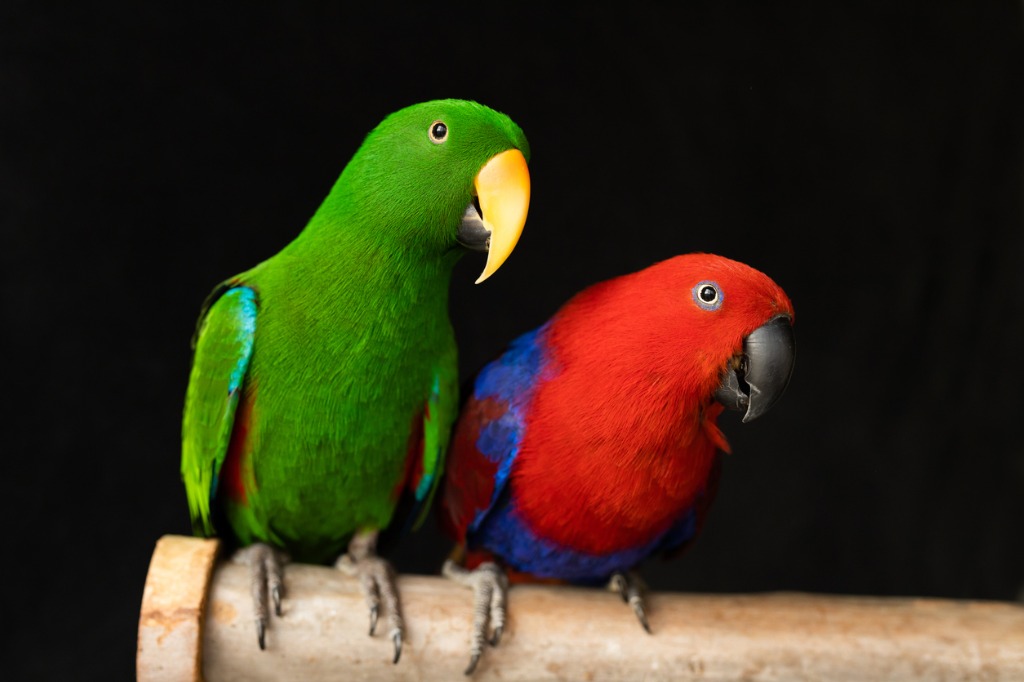Eclectus Parrots
 Eclectus parrots are often admired for their beauty and calm nature. They are unique in the parrot world because the male and female sex can be easily distinguished. Females are red while males are green. There are several different subspecies that are found in the Solomon islands, northeastern Australia, Maluku islands, New Guinea and Sumba.
Eclectus parrots are often admired for their beauty and calm nature. They are unique in the parrot world because the male and female sex can be easily distinguished. Females are red while males are green. There are several different subspecies that are found in the Solomon islands, northeastern Australia, Maluku islands, New Guinea and Sumba.
As with other species, it is important to keep eclectus parrots occupied with numerous toys and other activities for the day. Teaching a bird to forage for its food items can be very stimulating and help to avoid certain behavioral disorders. More on foraging can be found here. They are many toys available for eclectus parrots at pet stores. Home-made toys can also be used as a lower cost way of adding some stimulating objects for the birds to explore. People can use old boxes, cardboard paper towel rolls, and cleaned out plastic bottles and convert them into various types of toys.
Cage set-up requires that an eclectus have numerous size perches with variable width and texture. Natural wood perches like manzanita, java and dragonwood branches can be used. Cotton and sisal rope can be used as well. Pumice perches can be used to help keep nails trim but must be used cautiously. It is best to have only one pumice perch in the cage and keep it in a location where the bird will not stand on it the majority of the day. Sand paper perches should be avoided.
Getting exposure to ultraviolet- B radiation is recommended for all birds. This type of radiation allows for a bird to naturally make vitamin D3 in its body. This is then utilized to allow for calcium absorption from the diet. This calcium can then be used for laying eggs, building strong bones, having normal muscle contractions, and having a normal functioning nervous system. Birds can get exposure to ultraviolet-B radiation by being exposed to unfiltered sunlight. This means getting a bird outside in direct sunlight. Glass windows filter out all this important ultraviolet-B radiation. A bird should be monitored closely while outdoors however to ensure it does not over heat or fly away. If you do not have a safe way to give your bird access to unfiltered sunshine, a safe alternative is to provide a lamp that emits ultraviolet-B, such as Zoomed's Avisun 5.0. These lights should be 12-18 inches from the bird and used for around 6 hours a day.
Eclectus parrots require a slightly different diet from other types of psittacines. There have been occasions where eclectus parrots who get an all pellet diet have developed certain neurological abnormalities consisting of repeated wing flipping and toe tapping behavior. It has been found that when these birds get less pellets in the diet these signs go away. Although it is still beneficial to feed pellets, at this time it is recommended that the ratio be slightly less than what is recommended for most psittacines. No studies have been done to determine the exact nutritional needs of the eclectus parrot but many recommend that this species get no more than 50% pellets in the diet. Fresh foods should make up a significant part of the diet and can be about 30-50% of what the bird eats. Eclectus parrots should have higher amounts of fruit and fiber. Fruits like mangos, figs, guavas, bananas, citrus fruits, pears and apples are good options. Leafy greens such as endive, mustard, kale and dandelion should also be provided. A small amount of high quality seed, like nutriberries or avicakes should be offered and can be about 10-20% the diet. Nuts are recommended as well and include almonds and shelled walnuts.



